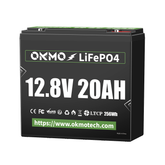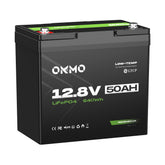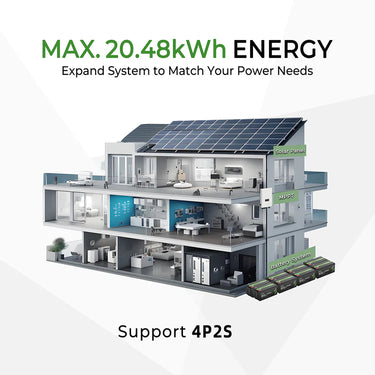What is a BMS (Battery Management System)?

In today's energy technology landscape, the Battery Management System (BMS) is regarded as the "intelligent core" of a battery pack, playing a role as vital as the human central nervous system. Whether in electric vehicles, solar energy storage systems, or portable power solutions, the BMS is key to ensuring battery safety, efficiency, and longevity. This article will delve into the working principles and core value of BMS, while recommending a flagship product that integrates advanced BMS and extreme-temperature management technology—the OKMO 12V 200Ah LiFePO4 Battery.

I. BMS: The "Intelligent Guardian" of Batteries
1. Definition and Core Functions of BMS
A BMS is an electronic control system that monitors, manages, and protects each cell within a battery pack (e.g., individual cells in a lithium-ion battery) to ensure safe operation. Its core functions include:
-
Voltage and Current Monitoring: Real-time detection of each cell's voltage and current to prevent damage from overcharging, over-discharging, or excessive current.
-
Temperature Management: Monitors battery temperature via sensors and adjusts charging/discharging rates in extreme temperatures to avoid thermal runaway (e.g., fires) or performance degradation in cold conditions.
-
Cell Balancing: Eliminates voltage differences between cells, ensuring synchronized charging and discharging to extend overall lifespan.
-
Safety Protections: Provides multiple safety mechanisms, including short-circuit protection, overload protection, and leakage detection.
2. How BMS Works
BMS achieves precise control through the following technologies:
-
Data Acquisition Module: Uses high-precision ADC (Analog-to-Digital Converter) to collect real-time data on cell voltage, temperature, etc.
-
Control Algorithms: Based on SOC (State of Charge) and SOH (State of Health) algorithms, it predicts battery performance and optimizes charging/discharging strategies.
-
Communication Interfaces: Supports protocols like CAN bus and RS485 for seamless interaction with external devices (e.g., chargers, inverters).
 II. Five Core Advantages of BMS
II. Five Core Advantages of BMS
1. Revolutionary Improvement in Safety
BMS reduces the risk of battery accidents to a minimum through multi-layer protection mechanisms. For example, if a cell's temperature exceeds 60°C, the BMS immediately cuts off the circuit to prevent thermal runaway.
2. Extended Lifespan by Over 50%
Traditional batteries without BMS often fail prematurely due to cell imbalances. BMS, through dynamic balancing technology, can extend the cycle life of LiFePO4 batteries from 3,000 cycles to over 5,000 cycles.
3. Adaptability to Extreme Environments
At -20°C, the capacity of ordinary lithium batteries may drop by 50%, but BMS-equipped batteries can maintain over 80% performance through preheating functions.
4. Energy Efficiency Optimization
BMS dynamically adjusts charging/discharging curves to reduce energy loss. For example, in solar energy storage systems, BMS can improve overall energy efficiency by 10%~15%.
5. User-Friendly Smart Management
Through mobile apps or displays, users can monitor battery status (e.g., remaining charge, health) in real time and remotely control charging/discharging strategies.

III. OKMO 12V 200Ah LiFePO4 Battery: The Pinnacle of BMS Technology
Among the many BMS-integrated battery products, the OKMO 12V 200Ah LiFePO4 Battery stands out as a benchmark for energy solutions in extreme environments, thanks to its innovative dual-system management architecture (BMS + LTCP).
1. Core Technical Highlights
-
Built-In Smart BMS:
-
Overcharge/Over-discharge Protection: Voltage precision control within ±10mV to prevent cell damage.
-
Dynamic Balancing Technology: Cell voltage differences <5mV throughout the lifecycle, extending lifespan to 15,000 cycles.
-
Multi-Layer Safety Protections: Short-circuit, reverse connection, and overcurrent protection with response times <10ms.
-
-
LTCP Extreme-Temperature Management System:
-
Low-Temperature Heating: In -30°C environments, PTC heating modules raise cell temperatures above 0°C to ensure normal operation.
-
High-Temperature Cooling: Built-in thermal silicone + smart fans improve heat dissipation efficiency by 40% at 55°C.
-
2. Performance Parameters and Application Scenarios
-
Ultra-Long Lifespan: 15,000 cycles (80% DoD), with a lifespan of over 10 years.
-
Wide Temperature Range: Operates in -30°C to 60°C, ideal for harsh environments like polar expeditions or desert solar installations.
-
Lightweight Design: Energy density of 140Wh/kg, 60% lighter than traditional lead-acid batteries, making it easy to transport or install.
-
Maintenance-Free: Fully sealed structure, supports installation at any angle, with no risk of acid leakage.
3. Recommended Applications
-
Off-Grid Solar Systems: Supports 24V/48V multi-battery configurations for 24/7 household power supply.
-
RVs and Marine Applications: IP67-rated shock and water resistance, suitable for bumpy roads and humid environments.
-
Industrial Equipment: Provides stable power for forklifts and AGVs, supporting high-rate discharge (1C continuous, 3C pulse).

IV. Why Choose OKMO Batteries?
The OKMO 12V 200Ah LiFePO4 Battery is not just an energy storage device but a "smart energy ecosystem." Its synergy of BMS and LTCP technologies redefines the reliability standards for batteries in extreme environments. Whether in the -30°C snowfields of Alaska or the 50°C deserts of the Sahara, OKMO batteries deliver stable output with over 95% efficiency, truly achieving "unwavering power in any environment."
Choose OKMO for a decade of energy freedom.
Conclusion

The advent of BMS marks a new era in battery technology, transitioning from "crude energy supply" to "intelligent management." The OKMO 12V 200Ah Battery is the perfect embodiment of this technology—it not only addresses energy challenges in extreme environments but also delivers long-term value through its ultra-long lifespan and maintenance-free design. Whether for home energy storage or industrial applications, OKMO is your most reliable "power partner."








